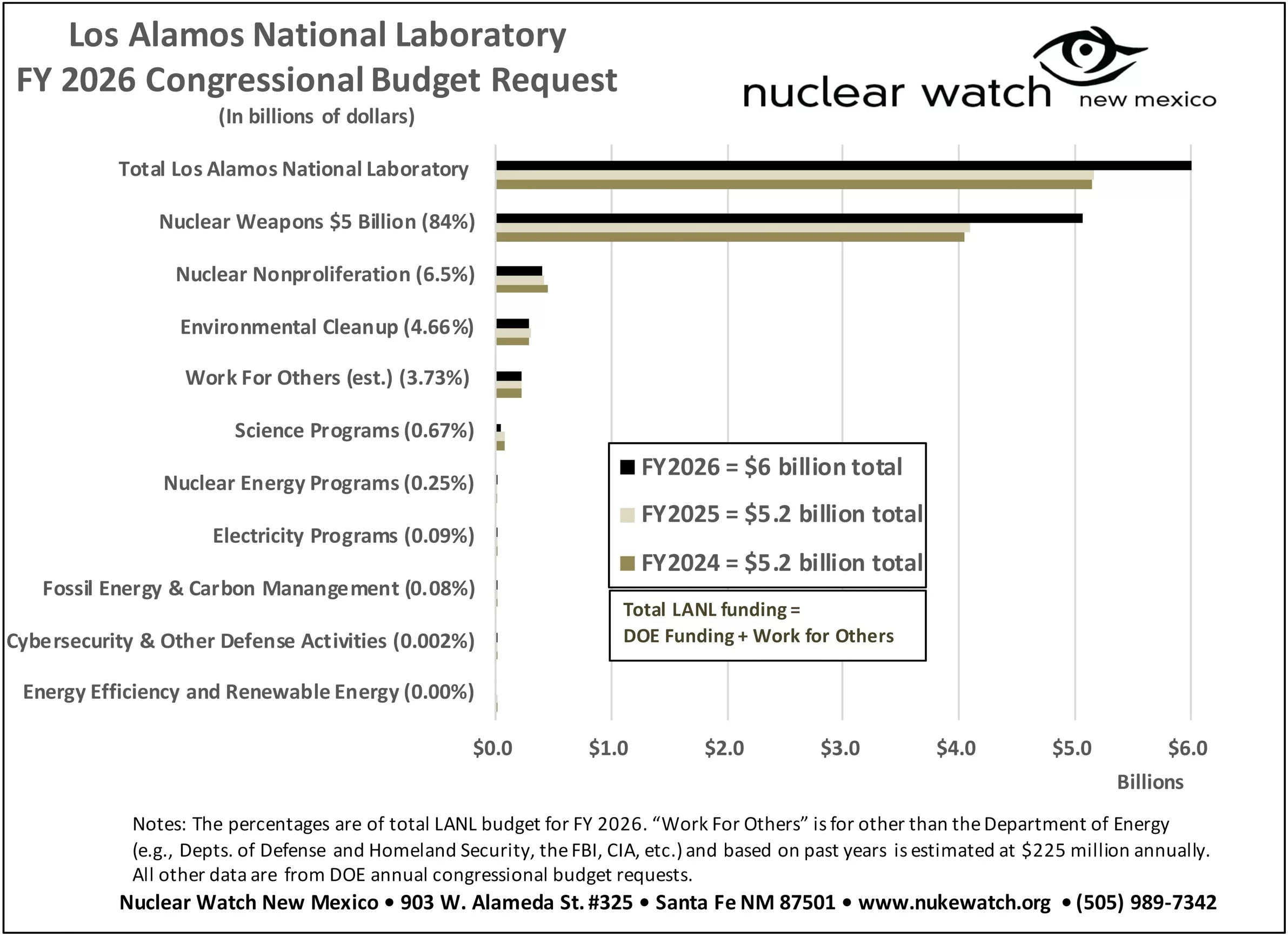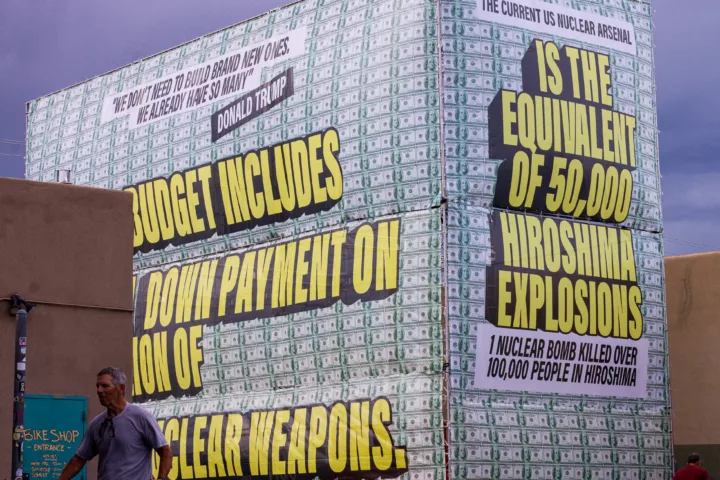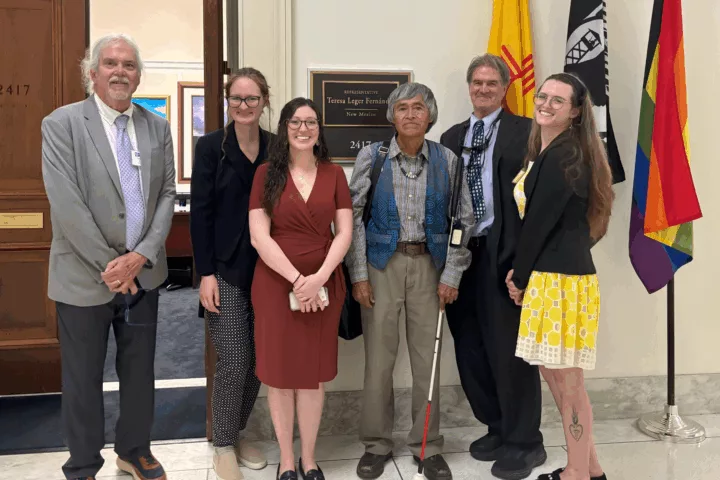
The Department of Energy and Los Alamos National Laboratory have released the LANL congressional budget request for the upcoming fiscal year, 2026, which begins on October 1, 2025. The request shows a continued major increase and expansion of the plutonium pit production program (plutonium pits are the triggers of nuclear weapons). LANL is frantically trying to increase its capabilities to begin making 30 pits per year by 2028.
NukeWatch created the attached chart to give a visual of how taxpayer dollars are annually spent at the Lab. LANL’s FY 2026 total budget request is $6 billion, which is a 17% increase over the FY 2025 $5.2 billion total budget. This includes a 24% increase in the nuclear weapons budget over FY 2025.
Nuclear Weapons Activities represent 84% of LANL’s total budget.
Under the headline of “Unleashing a Golden Era of Energy Dominance and Energy Innovation and Protecting the Nation,” the nuclear weapons budget is increasing dramatically. As a baseline, 65% of the Department’s proposed $46 billion budget is earmarked for its semi-autonomous nuclear weapons agency, the National Nuclear Security Administration (NNSA). In turn, more than 80% of NNSA’s proposed FY 2026 funding is for its nuclear weapons research and production programs, with a 25% funding increase over FY 2025.
Due to so-called “reconciliation” funding, “Total Weapons Activities” increase to just under $30 billion. This adds up to a 53% increase above FY 2025 for the nuclear weapons research and production programs across the country. To help pay for this, national nonproliferation and cleanup programs are being cut by 5%, science by 14%, cybersecurity and emergency response by 25%, and energy efficiency and renewable energy programs by 74%.
NNSA has yet to provide a credible justification for why expanded pit production is necessary in the first place. In 2006 independent experts concluded that pits last at least a century (their average age is now around 42). There are already at least 15,000 existing pits stored at the agency’s Pantex Plant near Amarillo, TX. In addition, new design nuclear weapons cannot be full scale tested because of the international testing moratorium, thereby perhaps eroding confidence in the stockpile. Or, in a worst-case scenario, these new designs could prompt the US to resume testing which would have severe international proliferation consequences.
All Other Programs at Los Alamos Are Cut.
On the other end of the chart, Energy Efficiency and Renewable Energy programs at the Lab for FY 2026 were cut to zero. NukeWatch believes that there are more appropriate, i.e. cost-effective places than Los Alamos to research renewable energy, but this underscores how the Lab is on a course of complete mission-narrowing by increasingly becoming solely a nuclear weapons production facility. The budget documents are not specific, but the Renewable Energy programs cuts were presumably to geothermal research.
(https://www.energy.gov/sites/default/files/2025-06/doe-fy-2026-vol-4-eere-v2.pdf pdf Pg. 10)
In fact, the FY 2026 budget request shows that weapons activities is the only program that is not proposed to get its budget cut at LANL. While at the same time, nuclear nonproliferation is on the chopping block with all the other non-weapons programs. Non-proliferation refers to efforts aimed at preventing the spread of nuclear weapons and technology to more countries, as well as reducing existing stockpiles. This involves both preventing the emergence of new nuclear-weapon states and limiting the growth of existing nuclear arsenals. (https://www.energy.gov/sites/default/files/2025-06/doe-fy-2026-vol-1.pdf pdf Pg. 472) NukeWatch believes that LANL would be good at nonproliferation and should be increasing its budget.
Cleanup at the Lab would be reduced to 4.7% of the Lab’s budget, or $281 million. This cut is despite the fact that DOE’s version of cleanup, which includes leaving most of the wastes of the Cold War buried in place, is currently scheduled to be “complete” in 2041 at a remaining high estimate of $12 billion dollars. Let’s do the math here: 2041 – 2026 = 15 years. $12 billion / 15 years = $800 million needed per year to “complete” cleanup by 2041. While the current request is an underwhelming $281 million. At this rate, it would take LANL until 2068 to “complete” cleanup.
(https://www.energy.gov/sites/default/files/2025-06/doe-fy-2026-vol-6-em.pdf pdf Pg. 39)
The stated mission of the Office of Nuclear Energy is “to advance nuclear power to meet the nation’s energy, environmental, and national security needs.” (https://www.energy.gov/sites/default/files/2025-06/doe-fy-2026-vol-4-ne.pdf NE Vol 4 pdf pg. 1) There is a dangerous major effort to extend the operational lifetimes of the US commercial reactors. Cutting back nuclear energy activities at LANL is a welcome step, but the U.S. must make a priority of figuring out what to do with the waste and cleaning up the abandoned uranium sites. In FY 2026, this subprogram will continue supporting technical experts at DOE national laboratories to develop technologies to improve in-situ uranium extraction efficiency for the domestic uranium mining industry.
The Office of Electricity “leads the U.S. Department of Energy’s research and development to strengthen and modernize our Nation’s power grid to maintain a reliable, affordable, secure, and resilient electricity delivery infrastructure.” Nation-wide, this program is looking at a 31% cut from last year. This involves national laboratories efforts to fully understand the resilience risks associated with the regionally diversified North American electric system and associated infrastructure systems. (https://www.energy.gov/sites/default/files/2025-06/doe-fy-2026-vol-4-oe.pdf Pdf Pg. 6)
The Office of Fossil Energy researches “technologies related to affordable, reliable, and secure use of fossil fuels that are important to our Nation’s security and economic prosperity while developing technological solutions for the prudent and sustainable development of our domestic coal, oil, gas, and critical minerals resources.” Even this office is looking at 31% cuts.
(https://www.energy.gov/sites/default/files/2025-06/doe-fy-2026-vol-4-fe.pdf pdf Pg. 1)
(The Science budget request has not been released.)
At some point, maybe the current administration will change the name of Los Alamos National Laboratory to Los Alamos Facility for Only Nuclear Pit Production (LAFFONPP).


